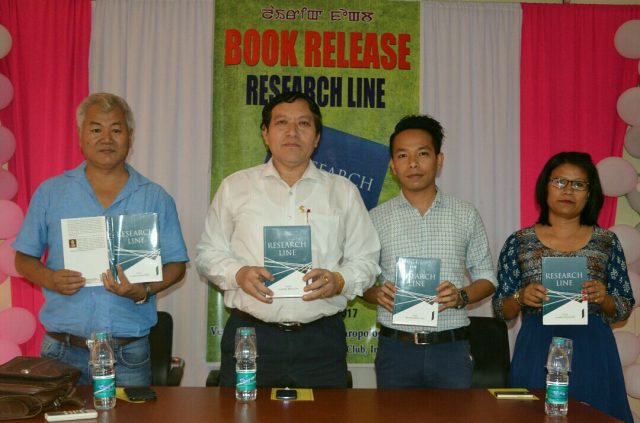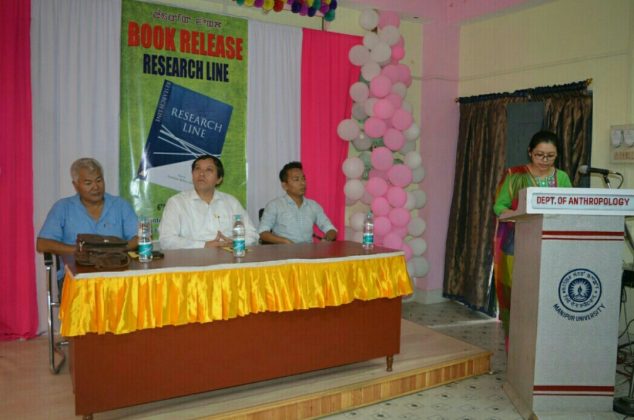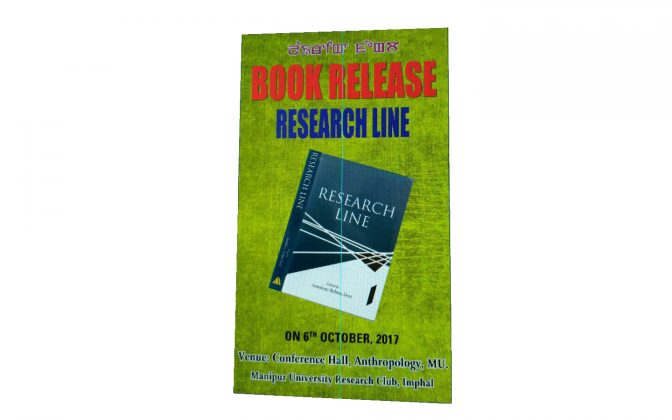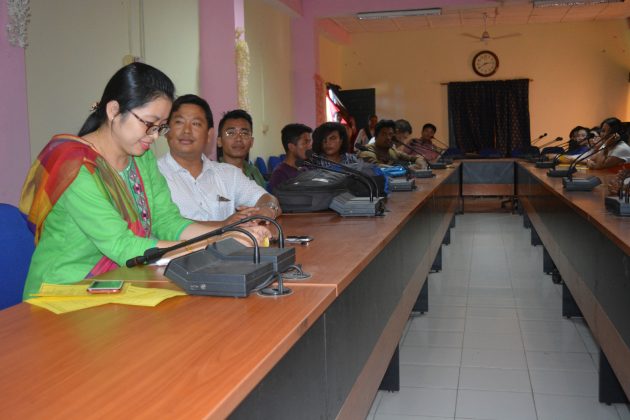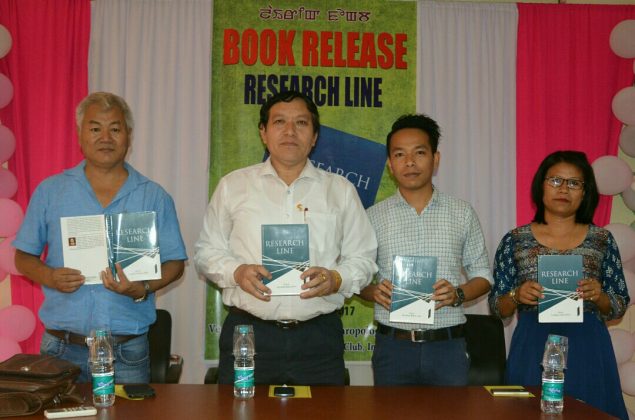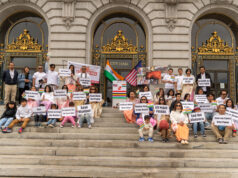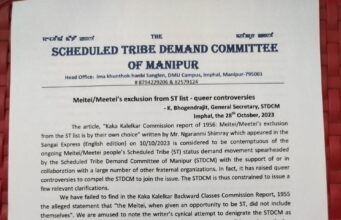By Aheibam Koireng Singh
6th october 2017 : The edited book titled, ‘Research Line’ bearing ISBN: 9788183705080, priced Rs. 850, edited by Arambam Bebina Devi, and published by Akansha Publishing House, N. Delhi was released today at the Conference Hall of Anthropology Dept., Manipur University (MU). Prof. RK Hemakumar Singh, formerly the Dean of Student’s Welfare, MU & Principal, Manipur Institute of Technology (MIT); Prof. MC Arunkumar, Head, Dept. of Anthropology, MU; and Hemam Nandakeshore, President, Manipur University Research Club (MURC) attended respectively as the Chief Guest, Guest of Honour, and the President. Dr. Narmada Hidangmayum, Scientist B, Dept. of Anthropology, Manipur University and also herself a contributor in this book delivered the Welcome Address.
Giving an exposition of the book, Bebina Arambam exhorted that the prime motivation of bringing out this book had been to facilitate the young scholars to excel in their thought process, which would definitely be helpful to them for further engagement in the theoretical and empirical research works. While talking about its contents, she said, the inter disciplinary discourse of all the wide range of discipline available in the University that took place or associated with the MURC one way or the other during her Presidentship tenure had as its outcome resulted to the publication of this book. And that, all the contributors were either associated with MU either as faculties or scholars.
Bebina Arambam then proceeds giving a glimpse of the contents in the book. The opening chapter, ‘Migrants and Culture Mainstreaming in Manipur’ by Sougaijam Priyokumar Meitei & M C Arunkumar attempts to draw a picture on mainstreaming process of the migrants with special reference to cultural integration focusing how people of different socio-cultural and racial profiles organise and respond in the new cultural milieu. It also identified the Bengolis, Nepalis, Bhojpuris, Punjabis, Marwari as the main important diasporic population. The second chapter, ‘A Statistical Analysis for the QSO Luminosity Function at z 1.1 to 2.9’ by Salam Ajit Kumar Singh & K. Yugindro Singh is an outcome of the study the shape of the luminosity functions of Quasi Stellar Objects (QSOs) over the redshift range 1.1 £ z £ 2.9 from the Sloan Digital Sky Survey Data Release Seven (SDSS DR7). It concludes with the observation that QSO luminosity function is well fitted by a double power-law model with second order polynomial evolution. The best fit parameters for model fitting are determined by using the Levenberg-Marquardt method of nonlinear least square fit. ‘Implementation of Saakshar Bharat Mission: 2012 with Special Reference to Tamenglong District, Manipur’ by Gaichangpou Ruangmei & S. Kiran Singh which constitutes the third chapter is an outcome of the study which confined only to Tamenglong district of Manipur on the implementation of Saakshar Bharat Mission,2012 from 15th January 2010 to 31st March, 2012 (1st phase) on women illiteracy. It concludes that the overall process of Saakshar Bharat Mission (SBM) in Tamenglong district was successfully implemented followed by the desired result of the increase in the literacy rate of women. The fourth chapter, ‘Study of Antenatal Care and Delivery Practices Among the Loi of Manipur’ by Tonjam Joshila Chanu is based on the input from married ‘Loi’ (Scheduled Caste) women aged 15-49 years from a sample of 575 households. It indicates that there are still substantial number of women among the Loi who need to be educated and awareness about the availability and benefits of ANC attendance and delivery institution.
The fifth chapter, ‘Structural and Electrical Properties of SOL-GEL Process Barium Titanate and Cobalt Ferrite Composites’ by H. Hemanta Singh, H. Basantakumar Sharma & G. Gaitoungam highlights the findings from the study of structural and electrical properties of Barium titanate and Cobalt ferrite composites (1-x) BTO-xCFO. The sixth chapter, ‘Implementation of Rajiv Gandhi Scheme for Empowerment of Adolescent Girls (RGSEAG) ‘Study on Sabla Scheme of Manipur’ by Th. Julia Kom elucidates that SABLA scheme will play an important role in the development of Adolescent Girls in the age group of 11-18 years regarding their health status, nutrition, home-base skill, life skill, vocational hygiene etc. with the adequate and timely provisions of Rice, pulses, Iron Folic Acid, Deworming tablets, vocational training, hygiene, menstruation practices etc. The seventh chapter, ‘Waiting for Bau Singh’s Left’ by Aheibam Koireng gives a descriptive of the anecdote which from that particular incident, the title of the chapter has become a much accepted vocabulary of the common parlance. The eighth chapter, ‘Impact of Literacy as Perceived by the Neo-Literates: A Case Study of Bishnupur District’ by Sonia Devi & Peichui Vashum attempt to assess the impact of literacy as perceived by the neo-literate in the Bishnupur District by employing case study approach under the descriptive method.
The ninth chapter ‘Measurement of Poverty: Its Nature and Dimensions’ by Salam Sovachandra Singh, among others describes the two terms – absolute and relative by which the concept of poverty can be defined. The tenth chapter, ‘Plant Parasitic and Soil Nematodes of Canchipur’ by S. Sushilkumar Singh & S. Mexico Singh revealed occurrence of large number of parasitic nematodes order Dorylaimida and Tylenchida and listed altogether twenty-one species belonging to nineteen genera of two orders. The eleventh chapter, ‘Myxozoan Parasites of Fishes of Thoubal District, Manipur’ by T. Soni & K. Lebanan, reported that during the course of investigation on the incidence of myxozoan parasites (Myxozoa: Bivalvulida) in fishes several species were found. They assume immense importance in view of their pathogenicity and mortality caused to their hosts. Species of genera Myxobolus, Thelohanellus and Henneguya from the gill filament, fins, and intestines of various fresh water fishes from Thoubal District, Manipur are reported. The twelfth chapter, ‘India’s Act East Policy and its Implication on Manipur’ by K. Muktasana Singh concludes that topographically, Manipur’s border town, Moreh – is the place where India Meets Myanmar in its journey to Southeast Asian. India’s Act East Policy aims to forge closer ties and physical connectivity with the Southeast Asian nations via Myanmar as well as to check Chinese trade and political expansion in the sub-continent.
The thirteenth chapter, ‘National Anti Doping Agency for Dope Free Sports’ by Maibam Chourjit Singh emphasized for the people actively involved in the field of sports to achieve the knowledge of doping and the banned substances for overall benefit of the athletes. The fourteenth chapter, ”Awareness of Gender Equality among Manipuris’ by L. Negrina Devi, Konika Khuraijam & R.K. Suresh highlights the need of conducting further studies involving all the men and women of different districts of Manipur as well as state-wise, incorporating other variables and dimensions such as educational level, income, occupation, community-wise, religions, social rights, cultural rights, and also Comparative study between members of patriarchal society and matriarchal society. The fifteenth chapter titled, ‘Parents’ Factors Affecting Parenting Stress of Mentally Challenged Children’ by Narmada Hidangmayum is an outcome of the study of parental factors such as self-efficacy, mental health, resilience and personality factors which could potentially affect parenting stress. It prioritizes a need to enhance resilience, self-efficacy, and mental health and also promote better personality dimensions to reduce parenting stress.
The sixteenth chapter, ‘Keikhu Village in Imphal East District, Manipur’ by Arambam Bebina Devi & Ch. Sonia Devi is an outcome of the study conducted with the objective of analysing the different level of educational status and rate of drop-out in different at Keikhu Kabui Village in Imphal. It concludes that the economic and social development of the village will be considerably lagged behind if proper attention is not given to the education of the village. The concluding and seventeenth chapter, ‘Libraries in Nursing and Paramedical Institutions of Manipur’ by Y. Ashakanan Devi & Ch. Ibohal assess the libraries of nursing and paramedical institutions in Manipur, their status, trends, and issues associated with them by undertaking micro level research. It asserts that, the libraries attached in such institutions of the state also, have to play their significant roles and responsibilities to make the nursing and paramedical education a success. However, researchers have given very little or no attention to it.
It was followed with a release of the book by the dignitary in the dais. Prof. MC Arunkumar, who during his students’ days was actively associated with the MURC in its formative days stated that today’s book release reminds him of the early days of MURC and made him nostalgic. MURC was conceived on the 13th November 1991. It was a collective wisdom and effort of scholars who believed in the critical discourse of human mind through academic research having had the experience of a chequered journey of one and half decades. In the heydays of the Club, talk programmes, lecture series, conferences and seminars were organized and had published in the form of working papers, booklets, etc. under the title – ‘Talk Line’, ‘Worm Series’ and ‘Interdis’. After a long gap it was rechristened as Research Update and made it into a volume and published from a multidisciplinary approach by the Club. The present volume, Research Line, is the footstep of the same. Among the luminaries who associated with the MURC, former Education Minister, Khumujam Ratankumar, was its formerly General Secretary, he stated. He concludes his speech by expressing his desire of widening the horizon and deepening the academic discourse through the collaborative effort of MURC, faculty members and members, so that ‘Research Line’ that was published would not be a just one time affair and its legacy be hopefully continued in posterity.
Prof. RK Hemakumar, in his speech as the functional Chief Guest, lauded the effort of the chapter contributors and editors and expresses his desire of uploading it to make it available for wider accessibility. The programme ended with a Vote of Thanks proposed by Sh. Nevedasko Sharma, SRF, ACEEE, Manipur University.

